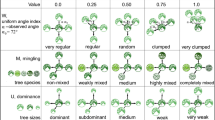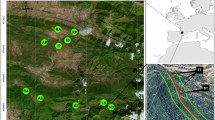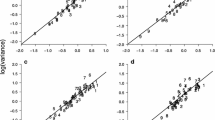Abstract
A model of a 1/12th ha forest stand, FORET, generated 10 000 years of simulated species succession. Approximately the first third of these results were analyzed by principal component analysis as if they were collected field data to give the trajectory of the community particle in a collapsed species space. The ordination axis orientation was performed on a dispersion matrix and correlation matrix between species. In both cases, however, the eigen vectors were applied to the data matrix which had not been transformed to unit species variance. This facilitated comparison of species dispersion and correlation structure; it emerged they were very different. Correlation structure gave large weights to understory species while dispersion emphasized the dominant overstory species. This implies a decomposition of simulated stand behavior into overstory and understory, even though such decomposition was not formally built into the model. This decomposition would seem to pertain to real vegetation.
Principal component analysis was able to express insightful differences between data structure with and without the unit variance transformation implicit in the correlation matrix. This flexibility of the ordination method proved valuable in uncovering unsuspected ordering principles in the model. Complex simulated data allow the ordination technique to demonstrate its capacity to generate new hypotheses, which hypotheses can then be simply validated by a return to the structure of the model but with the hindsight of the analysis. The generation of new hypotheses is not possible if the simulation is of a simple coenocline; on the other hand, ordination of test field data does not allow the simple validation of new hypotheses, for in the field there is not a defined algorithm to which the researcher can return.
Similar content being viewed by others
References
Allen, T. F. H. & Koonce, J. F., 1973. Multivariate approaches to algal stratagems and tactics in systems analysis of phytoplankton. Ecology 54: 1234–1246.
Allen, T. F. H. & Starr, T. B., 1982. Hierarchy: perspectives for ecological complexity. Univ. of Chicago Press. 326 pp.
Austin, M. P., 1976a. Performance of four ordination techniques assuming three different non-linear species response models. Vegetatio 33: 43–49.
Austin, M. P., 1976b. On non-linear species response models in ordination. Vegetatio 33: 33–41.
Austin, M. P. & Noy-Meir, I., 1971. The problem of non-linearity in ordination: experiments with two-gradient models. J. Ecol. 59: 763–773.
Beals, E. W., 1973. Ordination: Mathematical elegance and ecological naivete. J. Ecol 61: 23–26.
Beals, E. W., 1982. Bray-Curtis ordination: an effective strategy for analysis of multivariate ecological data. Adv. Ecol. Res. 13 (in press).
Botkin, D. B., Janak, J. F. & Wallis, J. R., 1972. Some ecological consequences of a computer model of forest growth. J. Ecol. 60: 849–873.
Bray, R. & Curtis, J. T., 1957. An ordination of the upland forest communities of southern Wisconsin. Ecol. Monogr. 27: 325–349.
Gauch, H. G., Jr. & Whittaker, R. H., 1972a. Comparison of ordination techniques. Ecology 53: 68–75.
Gauch, H. G., Jr. & Whittaker, R. H., 1972b. Coenocline simulation. Ecology 53: 446–451.
Gauch, H. G., Jr. & Whittaker, R. H., 1976. Simulation of community patterns. Vegetatio 33: 13–16.
Gauch, H. G., Jr., Whittaker, R. H. & Wentworth, T. R., 1977. A comparative study of reciprocal averaging and other ordination techniques. J. Ecol. 65: 157–174.
Gower, J. C., 1966. Some distance properties of latent root and vector methods used in multivariate analysis. Biometrika 53: 325–338.
Guttman, L., 1959. Metricizing rank-ordered or unordered data for linear factor analysis. Sankhya 21: 257–268.
Hill, M. O., 1973. Reciprocal averaging: an cigen vector method of ordination. J. Ecol. 61: 237–249.
Hill, M. O., 1974. Correspondence analysis: a negleeted multivariate method. J. Roy. Stat. Soc. Ser. C. 23: 340–354.
Kruskal, J. B., 1964. Nonmetric multidimensional scaling: A numerical method. Psychometrika 29: 28–42.
Maarel, E. van der, 1979. Transformation of cover-abundance values in phytosociology and its effects on community similarity. Vegetatio 39: 97–114.
Maarel, E. van der, 1981. On the interpretability of ordination diagrams. Vegetatio 42: 43–45.
Noy-Meir, I., 1973. Data transformation in ecological ordination, I. Some advantages of non-centering. J. Ecol. 61: 329–341.
Noy-Meir, I. & Austin, A. P., 1970. Prineipal component ordination and simulated vegetation data. Ecology 51: 551–552.
Noy-Meir, I., Walker, D. & Williams, W. T., 1975. Data transformation in ecological ordination. II. On the meaning of data standardization. J. Ecol. 63: 779–800.
Noy-Meir, I. & Whittaker, R. H., 1977. Continuous multivariate methods in community analysis: some problems and developments. Vegetatic 33: 79–98.
Orlóci, L., 1975. Multivariate analysis in vegetation research. Junk, The Hague, 276 pp.
Shugart, H. H., Jr. & West, D. C., 1977. Development of an Appalachian deciduous forest succession model and its application to assessment of the impact of the chestnut blight. J. Envir. Manage 5: 161–179.
Shugart, H. H., Jr. & West, D. C., 1979. Size and pattern of simulated forest stands. Forest Sci. 25: 120–122.
Swan, J. M. A., 1970. An examination of some ordination problems by use of simulated vegetation data. Ecology 51: 89–102.
Watt, A. S., 1947. Pattern and process in the plant community. J. Ecol. 35: 1–22.
Author information
Authors and Affiliations
Additional information
W. Post and J. Shepard of the Botany Department at Wisconsin wrote the PCAR program for principal component analysis. D. West and L. Tharp of Oak Ridge National Laboratory ran the FORET model and generated output compatible with the Datacraft computer for data reduction. Martin Burd assisted in preparation of the manuscript. The Research Committee of the Wisconsin Alumni Research Foundation supported costs of the Datacraft computer and software development. Preparation of the manuscript was supported by National Science Foundation Award DEB 78-07546 to the senior author. Research was also supported by NSF under interagency agreement 40-700-78 with the US Department of Energy.
Rights and permissions
About this article
Cite this article
Allen, T.F.H., Shugart, H.H. Ordination of simulated complex forest succession: A new test of ordination methods. Vegetatio 51, 141–155 (1983). https://doi.org/10.1007/BF00129433
Accepted:
Issue Date:
DOI: https://doi.org/10.1007/BF00129433




